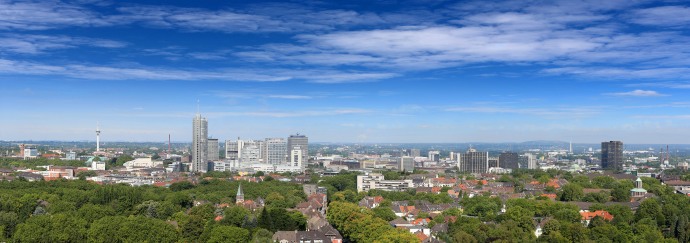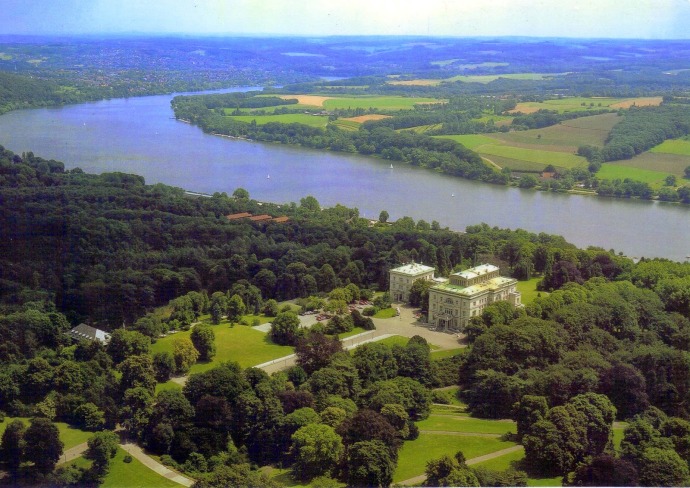Essen is a city located in North Rhine-Westphalia and is situated between the Rhine-Herne Canal and the Ruhr River. Founded in 852, Essen was originally the seat of an aristocratic convent, and is still represented by the Münsterkirche which was completed in the 15th century. The 19th stimulated Essen’s rapid growth from a small town to the largest industrial city in the Ruhr coalfield through the development of ironworks, steelworks and coalmines. The city was occupied by the French between 1923 and 1925 and suffered heavy damage during World War II. Since then the city has been rebuilt, but all of the coal mines have closed. The Zollverein coal-mine complex, once the largest in the world, was declared a UNESCO World Heritage site in 2001. Essen is now the industrial hub of the Ruhr, as well as a retail trade centre, a rail junction and business service centre. Essen is also home to many museums, including art, natural history and cultural collections, a philharmonic orchestra and many forests and parks (in the southern part of the city).
Zeche Zollverein (Zollverein Coal Mine Industrial Complex) – The Zollverein coal mine is a former industrial site in Essen. The first coal mine on the premises was created in 1847 and mining activities were undertaken between 1851 and 1986. The coal mine was originally founded by Franz Haniel who required coke (a very pure and carbon-rich fuel, usually made from coal) for steel production and test drillings concluded that there was a very rich layer of coal found in the Katernberg region (a suburb of Essen). The coal mine was named Zollverein after the German Customs Union, founded in 1934. Almost 100 years later, in 1937, the coal mine was employing almost 7,000 people and had an output of 3.6 million tons of coal. The mine survived World War II with only minor damages and became one of the most productive coke plants worldwide. However, by 1983 the coal mine was no longer profitable enough and parts of it were shut down. The state of North Rhine-Westphalia bought the coal mine territory and declared it a heritage site, which would ensure the preservation of the site. By 2000, the entire site was declared an official heritage site and was listed as a UNESCO World Heritage site in December 2001. Visitors are now able to go on a guided tour of the coal mine which includes a look at the technical processes, architectural features and a full explanation of the mine’s historical background. The Zollverein also hosts a variety of different events throughout the year including festivals and educational events.
 Villa Hügel – The Villa Hügel was built between 1870 and 1873 by Alfred Krupp and was intended as a residence for his family. The villa boasts 269 rooms with 8,100 square metres of useable floor space and is situated with 28ha of park. Alfred, his wife Bertha and son (and heir) Friedrich Alfred moved into the villa in 1873. The Krupp family is one of Essen’s most famous and influential families and owners of the Krupp AG, now ThyssenKrupp AG – a multinational conglomerate corporation based in Duisburg and Essen. The company is one of the world’s largest steel producers and further provides components and systems for the automotive industry, elevators, escalators, material trading and industrial services. The Krupp AG was originally founded by Friedrich Krupp in 1810. His son Alfred Krupp (creator of the Villa Hügel) took over the responsibility at just fourteen years of age after his father died in 1826. The company struggled for many years, but started to take off in 1841 and by 1847 Alfred produced his first cannon made of cast steel. Alfred would later be known as “the Cannon King”. In 1887 after Alfred’s death, his only son Friedrich Alfred took over the company and carried on the work. Throughout the 1900s the company was further passed down the line of Krupps (including Gustav who married into the family but took on his wife’s last name) and in 1999 Krupp merged with Thyssen (a major steel producer founded by August Thyssen in 1891), now known as ThyssenKrupp AG. This is only a brief history of the long Krupp history and the Villa thus represents not only the Krupp family’s residence, but is a symbol of German industrialisation.
Villa Hügel – The Villa Hügel was built between 1870 and 1873 by Alfred Krupp and was intended as a residence for his family. The villa boasts 269 rooms with 8,100 square metres of useable floor space and is situated with 28ha of park. Alfred, his wife Bertha and son (and heir) Friedrich Alfred moved into the villa in 1873. The Krupp family is one of Essen’s most famous and influential families and owners of the Krupp AG, now ThyssenKrupp AG – a multinational conglomerate corporation based in Duisburg and Essen. The company is one of the world’s largest steel producers and further provides components and systems for the automotive industry, elevators, escalators, material trading and industrial services. The Krupp AG was originally founded by Friedrich Krupp in 1810. His son Alfred Krupp (creator of the Villa Hügel) took over the responsibility at just fourteen years of age after his father died in 1826. The company struggled for many years, but started to take off in 1841 and by 1847 Alfred produced his first cannon made of cast steel. Alfred would later be known as “the Cannon King”. In 1887 after Alfred’s death, his only son Friedrich Alfred took over the company and carried on the work. Throughout the 1900s the company was further passed down the line of Krupps (including Gustav who married into the family but took on his wife’s last name) and in 1999 Krupp merged with Thyssen (a major steel producer founded by August Thyssen in 1891), now known as ThyssenKrupp AG. This is only a brief history of the long Krupp history and the Villa thus represents not only the Krupp family’s residence, but is a symbol of German industrialisation.
Museum Folkwang – The Museum Folkwang is home to a large collection of 19th and 20th century art. It was established in 1922 through the merging of the Essener Kunstmuseum (art museum) founded in 1906 and the private Folkwang Museum owned by Karl Ernst Osthaus, established in 1902. The name ‘Folkwang’ derives from the name of the afterlife meadow of the dead, Fólkvangr, from the Norse mythology (mythology of the North Germanic people stemming from Norse paganism). The museum contains 19th and 20th century art including works by Vincent van Gogh and Pierre-Auguste Renoir, modern art, photography, prints, drawings, as well as containing the German Poster Museum. The German Poster Museum (Deutsches Plakat Museum) contains more than 340,000 posters from politics, economics and culture ranging from the first posters produced to modern posters. Sachs (American businessman and museum director) described the museum as “The most beautiful museum in the world.” In addition to its permanent fixtures the museum hosts many special exhibits for limited periods. Current exhibits include ‘Photography in China’, ‘Conflict, Time, Photography’ and ‘Books and Films – Robert Frank.’





I’d love to see one on Darmstadt!
Although Darmstadt isn’t one of Germany’s largest 25 cities, we will do our best to write one for you 🙂
Vielen Dank!